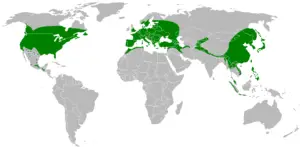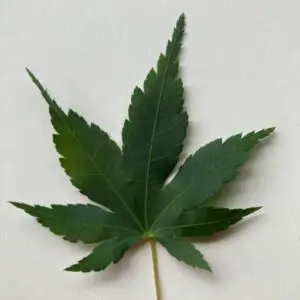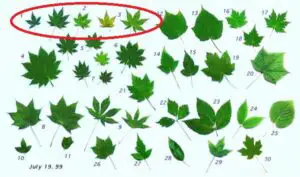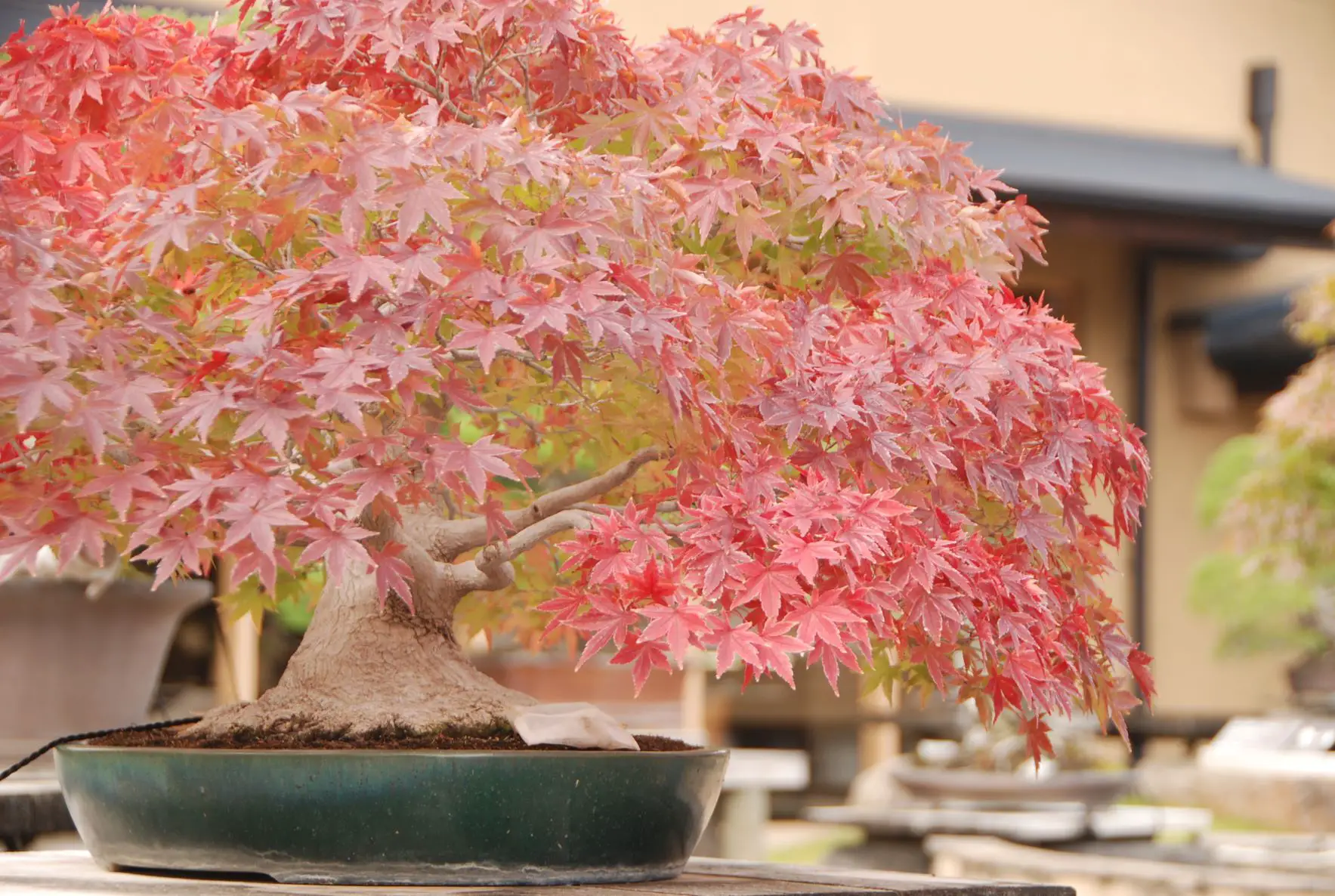When you go to the gardening store, you see so many different kinds of Japanese maples and might be wondering how many there are exactly.
By species, there are two Japanese maples: Acer palmatum and Acer amoenum. By classification of cultivars, there are seventeen Japanese maples. By the number of cultivars, there are around 1000 Japanese maples in the world.
Japanese maple: species
Maple trees in the world
Maple (genus: Acer) is one of the most diverse and widespread kinds of trees in the Northern hemisphere. There are 124-156 maple species in the world, 80% of which are native to Asia. Japanese maples are among those maples and there are 30 Acer (maple) growing naturally in Japan.

Distribution of maples
Number of Japanese maple species
What is “Japanese maple”?
When you hear the word “Japanese maple”, you probably think of a tree with pointed, deeply-lobed, serrated leaves like in the picture below.

Japanese maple leaf
In fact, this deeply-lobed maple tree is called “Momiji” in Japanese and is one of the two kinds of maples native to Japan. The other one is called “Kaede“. Most Kaede maples have leaves like sugar maples; slightly lobed with shallow incisions.
Momiji maple

Momiji (Acer palmatum)
Kaede maple

Kaede (Acer japonicum)
So, maple trees native to Japan can be divided into 2 groups: Momiji maple and Kaede maple. Momiji maples are those which have pointed, deeply lobed, serrated leaves, which usually indicate “Japanse maples”.
Momiji maple (Japanese maple)

Momiji maples (red circle) and other maple species in Japan
(Source)
Among 30 Acer (maple) species growing naturally in Japan, there are only 2 Japanese maple species: Acer palmatum and Acer amoenum. The latter Acer amoenum is further classified into two sub-varieties, Acer amoenum Carrière var. amoenum and Acer amoenum Carrière var. matsumurae∗.
1. Acer palmatum
2. Acer amoenum
– Acer amoenum Carrière var. amoenum
– Acer amoenum Carrière var. matsumurae
∗According to genetic research, Acer amoenum Carrière var. amoenum and Acer amoenum Carrière var. matsumurae are genetically indistinguishable from each other in domesticated cultivars, whereas the genetic difference between Acer palmatum and Acer amoenum is significant. (Source: 神崎 真哉, 井上 紘一, 宇都宮 直樹, 矢野 正善, SSRマーカーを用いたモミジの品種同定と遺伝的類縁関係の解析, 園芸学研究, 2013, 12 巻, 1 号, p. 1-7)
Because of their beautiful leaf colors and interesting leaf shapes, these Momiji maples have been cultivated for hundreds of years in Japan to have more desirable traits. In fact, all of the traditional Japanese maple cultivars are derived either from these two maple species: Acer palmatum and Acer amoenum.
Kaede maple
As to 27 Kaede maples, not much has been done to develop cultivars compared to Momiji maples (=Japanese maples). There are about a dozen cultivars with spots or of different shapes from the originals, but they are not actively grown in and outside of Japan by gardeners.
Japanese maple: cultivars classification
Groups of Japanese maple cultivars
According to The Maple Society, Japanese maple cultivars can be classified into the following 17 groups. This classification is organized by the color and shape of leaf, the color of the branches as well as the texture of the bark.
| Group Name | Description | Example |
| 1: Amoenum | Ordinary Japanese maple with no distinctive characteristics that assign them to other groups | Ohsakazuki |
| 2: Atropurpureum | Upright growing with red foliage | Bloodgood Yasemin |
| 3: Aureum | Yellow/orange spring foliage eventually turns yellow/lime green in summer | Katsura Summergold Jordan |
| 4: Convexum | Leaf with convex lobes | Trompenburg Pévé Starfish |
| 5: Corallinum | Bright pink spring color | Deshojo Ruben |
| 6: Crispum | Relatively small five-lobed curly leaves | Shishigashira Krazy Krinkle |
| 7: Dissectum | Deeply divided leaves till the base of the leaf, doubly serrated lobes, mostly weeping | Seiryu Garnet Dissectum |
| 8: Linearilobum | Extremely narrow lobes divided to the leaf base | Koto-no-ito |
| 9: Matsumurae | 7- to 9-lobed leaves divided to the leaf base, but not as strongly doubly serrate and without the weeping mushroom habit of the Dissectum Group | Soma-no-kawa |
| 10: Marginatum | Leaf margins distinctly different in color from the rest of the leaf (eg. white vs. green) | Kagiri-nishiki Butterfly |
| 11: Palmatum | No particular characteristic other than 5 lobed (occasionally 7) leaves, divided to no more than two-thirds of the leaf | Diane |
| 12: Pinebark | Rough pine-like bark | Nishiki-gawa |
| 13: Red wood | Bright red or orange winter branches | Sango-kaku |
| 14: Reticulatum | Leaf veins distinctly different in color (green/red) from rest of the leaf | Aka-shigitatsu-sawa Nathan |
| 15: Sessilifolium | 5-lobed leaves without a petiole and lobes reduced at the base to a petiole-like attachment | Beni-hagoromo Hazenoiro |
| 16: Variegatum | All other variegated Japanese maples not in the Marginatum Group (#10) | Uki-gumo |
| 17: Witches Broom | Reduced central lobe, restricted growth | Carlis Corner Broom |
(Source: The Maple Society)
1: Amoenum
2: Atropurpureum
3: Aureum
5: Corallinum
6: Crispum
7: Dissectum
8: Linearilobum
10: Marginatum
Leaf margins distinctly different in color from the rest of the leaf. Leaf margin color can be white or red/orange.
13: Red wood
Leaf shape/color and branch pattern of Japanese maples
The following is a comprehensive list of patterns that the current Japanese maple cultivars have; leaf shape patterns, leaf color patterns and branch/vein patterns.
Leaf shape patterns
Japanese maple has 10 leaf shape patterns as follows.
- Middle lobe reduced and usually shorter than the surrounding lobes
- Leaf sessile and lobes reduced at the base to the central nerve
- Lobes convex and usually seven or more lobes
- Leaf margin wavy or curly, no more than 5 lobes
- Leaf divided to the base, weeping
- Leaf divided to half the leaf blade or less
- Leaf divided to two-thirds
- Lobes strongly double toothed
- Lobes only lightly toothed or almost entire
- Lobes wider and clearly toothed
Leaf color patterns
Japanese maple has 6 leaf color patterns as follows. Color variations are green, red, orange, yellow and pink. Sometimes two different colors come together, particularly as leaf margin.
- Green in summer
- Red or reddish-green in summer
- Orange to yellow-green in spring and early summer
- Pink or pinkish-red in spring and early summer
- Leaf margin in a contrasting color
- Variegated leaves not just the margins
Branch/vein patterns
There are 4 branch/vein patterns as follows, which are characteristics of a small number of cultivars.
- Branches with a pine-like rough structure
- Winter branches red, orange or yellow
- Branches green or brown
- Veins in a contrasting color
(Source: The Maple Society)
Japanese maples: number of cultivars
Number of cultivars: historical change
Japanese maples have been actively cultivated in Japan for a few centuries and in the world since the 19th century. There are several Japanese books/catalogs dating back to 1710 that showcase Japanese maple cultivars. According to these books, the following is the number of Japanese maple cultivars at that time.
| Date | No. of Japanese maple cultivars∗ |
| 1710 | 36 |
| 1882 | 202 |
| 1891 | 173 |
| 1930 | 219 |
| 1967 | 127 |
∗ This number includes both Momiji maples and Kaede maples.
The number of Japanese maple cultivars in Japan decreased significantly from 219 to 127 after WW II. In fact, many of them literally disappeared because, sadly, Japanese maples are used as firewood and their nurseries were mandated for growing food during the war.
Numbers of cultivars: today
Today, Japanese maples are cultivated more enthusiastically outside of Japan due partly to their adaptiveness to different climates. The exact number of cultivars is unknown because people are producing different kinds of interesting Japanese maples and naming them as new ones that do not necessarily meet the definition to be called a cultivar.
What is a “cultivar”?
According to the International Code of Nomenclature for Cultivated Plants, a cultivar is defined as an assemblage of plants that (i) has been selected for a particular character or combination of characters, and (ii) remains distinct, uniform, and stable in these characters when propagated by appropriate means.
Some cultivars originate naturally as mutations in plants. Many old Japanese maple cultivars originated this way and are true to type, meaning propagation by seeds usually produces seedlings with (almost) the same characteristics as the parent tree.
Other more recent cultivars are an artificial hybrid of two different cultivars. This type of cultivar is usually not true to type. To have distinct characteristics as a cultivar, it must be propagated through cuttings and grafting. Propagation by seed usually produces something different than the parent plant.
Numbers of estimated current cultivars
With all being said, there are about 1000 Japanese maple cultivars around the world today, according to the Royal Horticultural Society (“RHS”) database∗. I suspect some of these do not have distinct, uniform, and stable characters that distinguish them from each other.
∗ There are 1093 results for Acer palmatum and 6 results for Acer amoenum when searched in RHS “Find a plant” page. Excluding the same cultivar with different names, there are 1003 Japanese maples left on the list.
—–
Reference
Gao, J., Liao, PC., Huang, BH. et al. Historical biogeography of Acer L. (Sapindaceae): genetic evidence for Out-of-Asia hypothesis with multiple dispersals to North America and Europe. Sci Rep 10, 21178 (2020)




-300x300.jpg)
-Acer-palmatum‘Nomura-300x300.jpg)
-300x300.jpg)
-Acer-palmatum-De-shojo-300x300.jpg)
-300x300.jpg)
-300x300.jpg)
-300x300.jpg)
-300x300.jpg)
-Acer-palmatum-‘Sangakaku-300x300.jpg)

